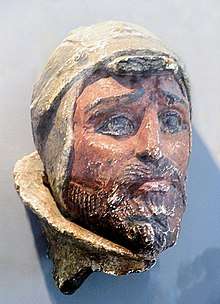Indo-Scythians
Indo-Scythians (also called Indo-Sakas) were a group of nomadic Iranian peoples of Saka and Scythian origin who migrated southward into western and northern South Asia (Sogdiana, Bactria, Arachosia, Gandhara, Sindh, Kashmir, Punjab, Haryana, Uttar Pradesh, Bihar, Rajasthan, Gujarat and Maharashtra) from the middle of the 2nd century BC to the 4th century AD.
Indo-Scythian Kingdom | |||||||||||||||||||
|---|---|---|---|---|---|---|---|---|---|---|---|---|---|---|---|---|---|---|---|
| c. 150 BCE–400 CE | |||||||||||||||||||
 Territories (green) and expansion (yellow) of the Indo-Scythian Kingdom at its greatest extent. | |||||||||||||||||||
| Capital | |||||||||||||||||||
| Common languages | Scythian, Greek Pali (Kharoshthi script) Sanskrit, Prakrit (Brahmi script) Possibly Aramaic | ||||||||||||||||||
| Religion | |||||||||||||||||||
| Government | Monarchy | ||||||||||||||||||
| King | |||||||||||||||||||
• 85–60 BCE | Maues | ||||||||||||||||||
• 10 CE | Hajatria | ||||||||||||||||||
| Historical era | Antiquity | ||||||||||||||||||
• Established | c. 150 BCE | ||||||||||||||||||
• Disestablished | 400 CE | ||||||||||||||||||
| Area | |||||||||||||||||||
| 20 est.[2] | 2,600,000 km2 (1,000,000 sq mi) | ||||||||||||||||||
| |||||||||||||||||||
| Outline of South Asian history | ||||||||||||||||||||||||||||||||||||||||||||
|---|---|---|---|---|---|---|---|---|---|---|---|---|---|---|---|---|---|---|---|---|---|---|---|---|---|---|---|---|---|---|---|---|---|---|---|---|---|---|---|---|---|---|---|---|
_without_national_boundaries.svg.png) | ||||||||||||||||||||||||||||||||||||||||||||
|
Palaeolithic (2,500,000–250,000 BC) |
||||||||||||||||||||||||||||||||||||||||||||
|
Neolithic (10,800–3300 BC)
|
||||||||||||||||||||||||||||||||||||||||||||
|
Chalcolithic (3500–1500 BC)
|
||||||||||||||||||||||||||||||||||||||||||||
|
Bronze Age (3300–1300 BC)
|
||||||||||||||||||||||||||||||||||||||||||||
|
Iron Age (1500–200 BC)
|
||||||||||||||||||||||||||||||||||||||||||||
|
Middle Kingdoms (230 BC – AD 1206) |
||||||||||||||||||||||||||||||||||||||||||||
|
Late medieval period (1206–1526)
|
||||||||||||||||||||||||||||||||||||||||||||
|
Early modern period (1526–1858)
|
||||||||||||||||||||||||||||||||||||||||||||
|
Colonial states (1510–1961)
|
||||||||||||||||||||||||||||||||||||||||||||
|
Periods of Sri Lanka
|
||||||||||||||||||||||||||||||||||||||||||||
|
Specialised histories |
||||||||||||||||||||||||||||||||||||||||||||
The first Saka king in South Asia was Maues/Moga (1st century BC) who established Saka power in Gandhara, and Indus Valley. The Indo-Scythians extended their supremacy over north-western India, conquering the Indo-Greeks and other local kingdoms. The Indo-Scythians were apparently subjugated by the Kushan Empire, by either Kujula Kadphises or Kanishka.[3] Yet the Saka continued to govern as satrapies,[4] forming the Northern Satraps and Western Satraps. The power of the Saka rulers started to decline in the 2nd century CE after the Indo-Scythians were defeated by the Satavahana emperor Gautamiputra Satakarni.[5][6] Indo-Scythian rule in the northwestern Indian subcontinent ceased when the last Western Satrap Rudrasimha III was defeated by the Gupta emperor Chandragupta II in 395 CE.[7][8]
The invasion of northern regions of the Indian subcontinent by Scythian tribes from Central Asia, often referred to as the Indo-Scythian invasion, played a significant part in the history of the Indian subcontinent as well as nearby countries. In fact, the Indo-Scythian war is just one chapter in the events triggered by the nomadic flight of Central Asians from conflict with tribes such as the Xiongnu in the 2nd century AD, which had lasting effects on Bactria, Kabul, and the Indian subcontinent as well as far-off Rome in the west, and more nearby to the west in Parthia.
Ancient Roman historians including Arrian[9] and Claudius Ptolemy have mentioned that the ancient Sakas ('Sakai') were nomadic people.[10] However, Italo Ronca, in his detailed study of Ptolemy's chapter vi, states: "The land of the Sakai belongs to nomads, they have no towns but dwell in forests and caves" as spurious.[11]
Origins
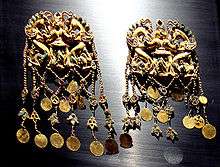
The ancestors of the Indo-Scythians are thought to be Sakas (Scythian) tribes.
"One group of Indo-European speakers that makes an early appearance on the Xinjiang stage is the Saka (Ch. Sai). Saka is more a generic term than a name for a specific state or ethnic group; Saka tribes were part of a cultural continuum of early nomads across Siberia and the Central Eurasian steppe lands from Xinjiang to the Black Sea. Like the Scythians whom Herodotus describes in book four of his History (Saka is an Iranian word equivalent to the Greek Scythes, and many scholars refer to them together as Saka-Scythian), Sakas were Iranian-speaking horse nomads who deployed chariots in battle, sacrificed horses, and buried their dead in barrows or mound tombs called kurgans."[15]
Achaemenid period (6th-4th century BCE)
During the Achaemenid conquest of the Indus Valley circa 515 BCE, the Achaemenid army was not uniquely Persian, and the Sakas probably participated in the invasion of northwestern India. The Achaemenid army was composed of many different ethnicities that were part of the vast Achaemenid Empire. The army included Bactrians, Sakas (Scythians), Parthians, Sogdians.[16] Herodotus gives a full list of the ethnicities of the Achaemenid army, in which are included Sakas together with Ionians (Greeks), and even Ethiopians.[17][16] These ethnicities are likely to have been included in the Achaemenid army which invaded India.[16]
Some scholars, including Michael Witzel[18] and Christopher I. Beckwith[19] suggested that the Shakyas, the clan of the historical Gautama Buddha, were originally Scythians from Central Asia, and that the Indian ethnonym Śākya has the same origin as “Scythian”, called Sakas in India.[16] This would also explain the strong support of the Sakas for the Buddhist faith in India.[19]
The Persians, the Sakas and the Greeks, may have later participated in the campaigns of Chandragupta Maurya to gain the throne of Magadha circa 320 BCE. The Mudrarakshasa states that after Alexander's death, an alliance of "Shaka-Yavana-Kamboja-Parasika-Bahlika" was used by Chandragupta Maurya in his campaign to take the throne in Magadha and found the Mauryan Empire.[20][21][22] The Sakas were the Scythians, the Yavanas were the Greeks, and the Parasikas were the Persians.[21][23]
Yuezhi expansion (2nd century BCE)
In the 2nd century BC, a fresh nomadic movement started among the Central Asian tribes, producing lasting effects on the history of Rome in Europe, Parthia in Western Asia, and Bactria, Kabul, and India in the east in Southern Asia. Recorded in the annals of the Han dynasty and other Chinese records, this great tribal movement began after the Yuezhi tribe was defeated by the Xiongnu, fleeing westwards after their defeat and creating a domino effect as they displaced other central Asian tribes in their path.[24]

According to these ancient sources Modu Shanyu of the Xiongnu tribe of Mongolia attacked the Yuezhi (possibly related to the Tocharians who lived in eastern Tarim Basin area) and evicted them from their homeland between the Qilian Shan and Dunhuang around 175 BC.[25] Leaving behind a remnant of their number, most of the population moved westwards into the Ili River area. There, they displaced the Sakas, who migrated south into Ferghana and Sogdiana. According to the Chinese historical chronicles (who call the Sakas, "Sai" 塞): "[The Yuezhi] attacked the king of the Sai who moved a considerable distance to the south and the Yuezhi then occupied his lands."[26][27]
Sometime after 155 BC, the Yuezhi were again defeated by an alliance of the Wusun and the Xiongnu, and were forced to move south, again displacing the Scythians, who migrated south towards Bactria and present Afghanistan, and south-west closer towards Parthia.
The Sakas seem to have entered the territory of the Greco-Bactrian Kingdom around 145 BC, where they burnt to the ground the Greek city of Alexandria on the Oxus. The Yuezhi remained in Sogdiana on the northern bank of the Oxus, but they became suzerains of the Sakas in Bactrian territory, as described by the Chinese ambassador Zhang Qian who visited the region around 126 BC.
In Parthia, between 138–124 BC, a tribe known to ancient Greek scholars as the Sacaraucae (probably from the Old Persian Sakaravaka "nomadic Saka") and an allied, possibly non-Saka/Scythian people, the Massagetae came into conflict with the Parthian Empire. The Sacaraucae-Massagetae alliance won several battles and killed, in succession, the Parthian kings Phraates II and Artabanus I.
The Parthian king Mithridates II finally retook control of parts of Central Asia, first by defeating the Yuezhi in Sogdiana in 115 BC, and then defeating the Scythians in Parthia and Seistan around 100 BC.
After their defeat, the Yuezhi tribes migrated relatively far to the east into Bactria, which they were to control for several centuries, and from which they later conquered northern India to found the Kushan Empire.[28]
Settlement in Sakastan
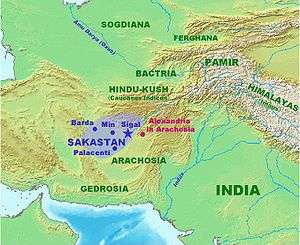
The Sakas settled in Drangiana, an area of Southern Afghanistan, western Pakistan and south Iran, which was then called after them as Sakastan or Sistan.[29] From there, they progressively expanded into present day Iran as well as northern India, where they established various kingdoms, and where they are known as "Saka".
The Arsacid emperor Mithridates II (c. 123–88/87 BCE) claimed many successes in battle and added many provinces to the Parthian Empire.[30] Apparently the Scythian hordes that came from Bactria were conquered by him.
Following military pressure from the Yuezhi (precursors of the Kushana), a section of the Indo-Scythians moved from Bactria to Lake Helmond (or Hāmūn), and settled in or around Drangiana (Sigal), a region which later came to be called "Sakistana of the
Skythian Sakai [sic]",[31] towards the end of 1st century BC.[32] The region is still known as Seistan.
I
The presence of the Sakas in Sakastan in the 1st century BC is mentioned by Isidore of Charax in his "Parthian stations". He explained that they were bordered at that time by Greek cities to the east (Alexandria of the Caucasus and Alexandria of the Arachosians), and the Parthian-controlled territory of Arachosia to the south:
- "Beyond is Sacastana of the Scythian Sacae, which is also Paraetacena, 63 schoeni. There are the city of Barda and the city of Min and the city of Palacenti and the city of Sigal; in that place is the royal residence of the Sacae; and nearby is the city of Alexandria (Alexandria Arachosia), and six villages." Parthian stations, 18.[33]
Indo-Scythian kingdoms
Pamirs to Taxila

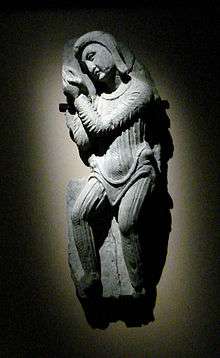
Ahmad Hassan Dani and professor Karl Jettmar, from the petroglyphs left by Saka soldiers at principle river crossings at Chilas and the Sacred Rock of Hunza, have established the route across the Karakoram mountains used by Maues, the first Indo-Scythian king, to capture Taxila from Indo-Greek King Apollodotus II.[34]
The 1st century AD Periplus of the Erythraean Sea describes the Scythian territories there:
"Beyond this region (Gedrosia), the continent making a wide curve from the east across the depths of the bays, there follows the coast district of Scythia, which lies above toward the north; the whole marshy; from which flows down the river Sinthus, the greatest of all the rivers that flow into the Erythraean Sea, bringing down an enormous volume of water (...) This river has seven mouths, very shallow and marshy, so that they are not navigable, except the one in the middle; at which by the shore, is the market-town, Barbaricum. Before it there lies a small island, and inland behind it is the metropolis of Scythia, Minnagara; it is subject to Parthian princes who are constantly driving each other out.."[35]
The Indo-Scythians ultimately established a kingdom in the northwest, based near Taxila, with two great Satraps, one in Mathura in the east, and one in Surastrene (Gujarat) in the southwest.
In the southeast, the Indo-Scythians invaded the area of Ujjain, but were subsequently repelled in 57 BC by the Malwa king Vikramaditya. To commemorate the event Vikramaditya established the Vikrama era, a specific Indian calendar starting in 57 BC. More than a century later, in AD 78, the Sakas would again invade Ujjain and establish the Saka era, marking the beginning of the long-lived Saka Western Satraps kingdom.[36]
Gandhara and Punjab

The presence of the Scythians in north-western India during the 1st century BCE was contemporary with that of the Indo-Greek Kingdoms there, and it seems they initially recognized the power of the local Greek rulers.
Maues first conquered Gandhara and Taxila around 80 BCE, but his kingdom disintegrated after his death. In the east, the Indian king Vikrama retook Ujjain from the Indo-Scythians, celebrating his victory by the creation of the Vikrama era (starting 58 BCE). Indo-Greek kings again ruled after Maues, and prospered, as indicated by the profusion of coins from Kings Apollodotus II and Hippostratos. Not until Azes I, in 55 BC, did the Indo-Scythians take final control of northwestern India, with his victory over Hippostratos.
Sculpture
Several stone sculptures have been found in the Early Saka layer (Layer No4, corresponding to the period of Azes I, in which numerous coins of the latter were found) in the ruins of Sirkap, during the excavations organized by John Marshall.
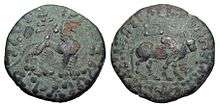
Several of them are toilet trays (also called Stone palettes) roughly imitative of earlier, and finer, Hellenistic ones found in the earlier layers. Marshall comments that "we have a praiseworthy effort to copy a Hellenistic original but obviously without the appreciation of form and skill which were necessary for the task". From the same layer, several statuettes in the round are also known, in very rigid and frontal style.
Bimaran casket
Azes is connected to the Bimaran casket, one of the earliest representations of the Buddha. The casket was used for the dedication of a stupa in Bamiran, near Jalalabad in Afghanistan, and placed inside the stupa with several coins of Azes. This event may have happened during the reign of Azes (60–20 BCE), or slightly later. The Indo-Scythians are otherwise connected with Buddhism (see Mathura lion capital), and it is indeed possible they would have commended the work.
Mathura area ("Northern Satraps")
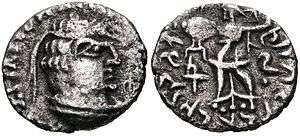
Obv: Bust of King Rajuvula, with Greek legend.
Rev: Pallas standing right (crude). Kharoshthi legend.
In northern India, the Indo-Scythians conquered the area of Mathura over Indian kings around 60 BCE. Some of their satraps were Hagamasha and Hagana, who were in turn followed by the Saca Great Satrap Rajuvula.
The Mathura lion capital, an Indo-Scythian sandstone capital in crude style, from Mathura in northern India, and dated to the 1st century CE, describes in kharoshthi the gift of a stupa with a relic of the Buddha, by Queen Nadasi Kasa, the wife of the Indo-Scythian ruler of Mathura, Rajuvula. The capital also mentions the genealogy of several Indo-Scythian satraps of Mathura.
Rajuvula apparently eliminated the last of the Indo-Greek kings Strato II around 10 CE, and took his capital city, Sagala.
The coinage of the period, such as that of Rajuvula, tends to become very crude and barbarized in style. It is also very much debased, the silver content becoming lower and lower, in exchange for a higher proportion of bronze, an alloying technique (billon) suggesting less than wealthy finances.
The Mathura lion capital inscriptions attest that Mathura fell under the control of the Sakas. The inscriptions contain references to Kharahostes and Queen Ayasia, the "chief queen of the Indo-Scythian ruler of Mathura, satrap Rajuvula." Kharahostes was the son of Arta as is attested by his own coins.[37] Arta is stated to be brother of King Moga or Maues.[38]
The Indo-Scythian satraps of Mathura are sometimes called the "Northern Satraps", in opposition to the "Western Satraps" ruling in Gujarat and Malwa. After Rajuvula, several successors are known to have ruled as vassals to the Kushans, such as the "Great Satrap" Kharapallana and the "Satrap" Vanaspara, who are known from an inscription discovered in Sarnath, and dated to the 3rd year of Kanishka (c. AD 130), in which they were paying allegiance to the Kushans.[39]
Pataliputra

The text of the Yuga Purana describes an invasion of Pataliputra by the Scythians sometimes during the 1st century BC, after seven great kings had ruled in succession in Saketa following the retreat of the Yavanas. The Yuga Purana explains that the king of the Sakas killed one fourth of the population, before he was himself slain by the Kalinga king Shata and a group of Sabalas (Sabaras or Bhillas).[40]
Kushan and Indo-Parthian conquests
After the death of Azes, the rule of the Indo-Scythians in northwestern India was shattered with the rise of the Indo-Parthian ruler Gondophares in the last years of the 1st century BC. For the following decades, a number of minor Scythian leaders maintained themselves in local strongholds on the fringes of the loosely assembled Indo-Parthian empire, some of them paying formal allegiance to Gondophares I and his successors.
During the latter part of the 1st century AD, the Indo-Parthian overlordship was gradually replaced with that of the Kushans, one of the five tribes of the Yuezhi who had lived in Bactria for more than a century, and were now expanding into India to create a Kushan Empire. The Kushans ultimately regained northwestern India from around AD 75, and the area of Mathura from around AD 100, where they were to prosper for several centuries.[28]
Western Kshatrapas legacy

Indo-Scythians continued to hold the area of Seistan until the reign of Bahram II (AD 276–293), and held several areas of India well into the 1st millennium: Kathiawar and Gujarat were under their rule until the 5th century under the designation of Western Kshatrapas, until they were eventually conquered by the Gupta emperor Chandragupta II (also called Vikramaditya).
Indo-Scythian coinage
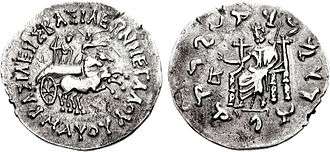
Indo-Scythian coinage is generally of a high artistic quality, although it clearly deteriorates towards the disintegration of Indo-Scythian rule around AD 20 (coins of Rajuvula). A fairly high-quality but rather stereotypical coinage would continue in the Western Satraps until the 4th century.
Indo-Scythian coinage is generally quite realistic, artistically somewhere between Indo-Greek and Kushan coinage. It is often suggested Indo-Scythian coinage benefited from the help of Greek celators (Boppearachchi).
Indo-Scythian coins essentially continue the Indo-Greek tradition, by using the Greek language on the obverse and the Kharoshthi language on the reverse. The portrait of the king is never shown however, and is replaced by depictions of the king on horse (and sometimes on camel), or sometimes sitting cross-legged on a cushion. The reverse of their coins typically show Greek divinities.
Buddhist symbolism is present throughout Indo-Scythian coinage. In particular, they adopted the Indo-Greek practice since Menander I of showing divinities forming the vitarka mudra with their right hand (as for the mudra-forming Zeus on the coins of Maues or Azes II), or the presence of the Buddhist lion on the coins of the same two kings, or the triratana symbol on the coins of Zeionises.
Depiction of Indo-Scythians

Besides coinage, few works of art are known to indisputably represent Indo-Scythians. Indo-Scythian rulers are usually depicted on horseback in armour, but the coins of Azilises show the king in a simple, undecorated, tunic.
Several Gandharan sculptures also show foreigners in soft tunics, sometimes wearing the typical Scythian cap. They stand in contrast to representations of Kushan men, who seem to wear thick, rigid, tunics, and who are generally represented in a much more simplistic manner.[41]
Buner reliefs
Indo-Scythian soldiers in military attire are sometimes represented in Buddhist friezes in the art of Gandhara (particularly in Buner reliefs). They are depicted in ample tunics with trousers, and have heavy straight swords as weapons. They wear pointed hoods (the Scythian cap or bashlyk), which distinguishes them from the Indo-Parthians who only wore a simple fillet over their bushy hair,[42] and which is also systematically worn by Indo-Scythian rulers on their coins. With the right hand, some of them are forming the Karana mudra against evil spirits. In Gandhara, such friezes were used as decorations on the pedestals of Buddhist stupas. They are contemporary with other friezes representing people in purely Greek attire, hinting at an intermixing of Indo-Scythians (holding military power) and Indo-Greeks (confined, under Indo-Scythian rule, to civilian life).
Another relief is known where the same type of soldiers are playing musical instruments and dancing, activities which are widely represented elsewhere in Gandharan art: Indo-Scythians are typically shown as reveling devotees.
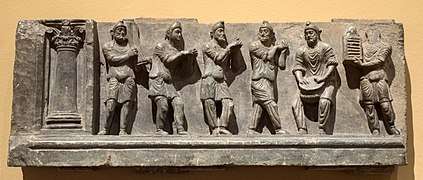 One of the Buner reliefs showing Scythian soldiers dancing. Cleveland Museum of Art.
One of the Buner reliefs showing Scythian soldiers dancing. Cleveland Museum of Art.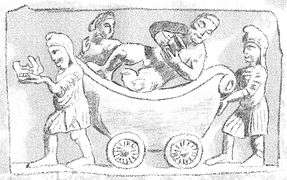 Indo-Scythians pushing along the Greek god Dionysos with Ariadne.[43]
Indo-Scythians pushing along the Greek god Dionysos with Ariadne.[43]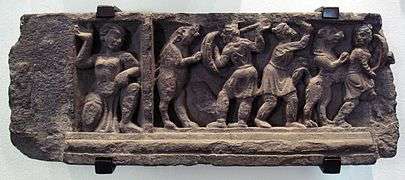 Hunting scene.
Hunting scene.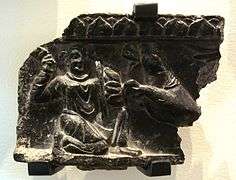 Hunting scene.
Hunting scene.
Stone palettes

Numerous stone palettes found in Gandhara are considered good representatives of Indo-Scythian art. These palettes combine Greek and Iranian influences, and are often realized in a simple, archaic style. Stone palettes have only been found in archaeological layers corresponding to Indo-Greek, Indo-Scythian and Indo-Parthian rule, and are essentially unknown in the preceding Mauryan layers or the succeeding Kushan layers.[44]
Very often these palettes represent people in Greek dress in mythological scenes, a few in Parthian dress (head-bands over bushy hair, crossed-over jacket on a bare chest, jewelry, belt, baggy trousers), and even fewer in Indo-Scythian dress (Phrygian hat, tunic and comparatively straight trousers). A palette found in Sirkap and now in the New Delhi Museum shows a winged Indo-Scythian horseman riding winged deer, and being attacked by a lion.
The Indo-Scythians and Buddhism
The Indo-Scythians seem to have been followers of Buddhism, and many of their practices apparently continued those of the Indo-Greeks.
Royal dedications
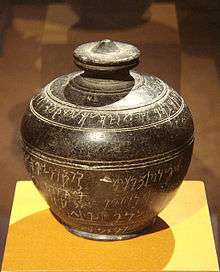
Several Indo-Scythian kings after Azes are known for making Buddhist dedications in their name, on plaques or reliquaries:
- Patika Kusulaka (25 BCE – 10 CE) related his donation of a relic of the Buddha Shakyamuni to a Buddhist monastery, in the Taxila copper plate.
- Kharahostes (10 BCE – 10 CE) is mentioned on the Buddhist Mathura lion capital and on a reliquary.[46][47] His coins were also found in the Bimaran casket, a beautiful Buddhist gold reliquary with an early image of the Buddha, now in the British Museum. Some of his coins bear the Buddhist triratna symbol.
- Vijayamitra (ruled 12 BCE - 15 CE) personally dedicated in his name a Buddhist reliquary.[48][49] Some of his coins bear the Buddhist triratna symbol.
- Indravarman, while still a Prince, personally dedicated in 5-6 CE a Buddhist reliquary, the Bajaur casket, now in the Metropolitan Museum of Art.
- Zeionises and Aspavarma also used the Buddhist triratna symbol on their coins.
- Rajuvula erected the Mathura lion capital, which incorporates Buddhist symbols and relates the donations by his wife of relics to a stupa.
Butkara Stupa
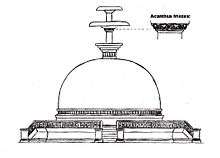
Excavations at the Butkara Stupa in Swat by an Italian archaeological team have yielded various Buddhist sculptures thought to belong to the Indo-Scythian period. In particular, an Indo-Corinthian capital representing a Buddhist devotee within foliage has been found which had a reliquary and coins of Azes buried at its base, securely dating the sculpture to around 20 BC.[52] A contemporary pilaster with the image of a Buddhist devotee in Greek dress has also been found at the same spot, again suggesting a mingling of the two populations.[53] Various reliefs at the same location show Indo-Scythians with their characteristic tunics and pointed hoods within a Buddhist context, and side-by-side with reliefs of standing Buddhas.[54]
Gandharan sculptures
Other reliefs have been found, which show Indo-Scythian men with their characteristic pointed cap pushing a cart on which is reclining the Greek god Dionysos with his consort Ariadne.
Mathura lion capital
The Mathura lion capital, which associates many of the Indo-Scythian rulers from Maues to Rajuvula, mentions a dedication of a relic of the Buddha in a stupa. It also bears centrally the Buddhist symbol of the triratana, and is also filled with mentions of the bhagavat Buddha Sakyamuni, and characteristically Buddhist phrases such as:
- "sarvabudhana puya dhamasa puya saghasa puya"
- "Revere all the Buddhas, revere the dharma, revere the sangha"
- (Mathura lion capital, inscription O1/O2)
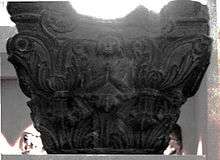 Indo-Corinthian capital from Butkara Stupa, dated to 20 BC, during the reign of Azes II. Turin City Museum of Ancient Art.
Indo-Corinthian capital from Butkara Stupa, dated to 20 BC, during the reign of Azes II. Turin City Museum of Ancient Art. Dancing Indo-Scythians (top) and hunting scene (bottom). Buddhist relief from Swat, Gandhara.
Dancing Indo-Scythians (top) and hunting scene (bottom). Buddhist relief from Swat, Gandhara. Butkara doorjamb, with Indo-Scythians dancing and reveling. On the back side is a relief of a standing Buddha[55]
Butkara doorjamb, with Indo-Scythians dancing and reveling. On the back side is a relief of a standing Buddha[55]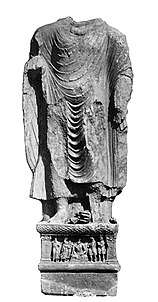 Statue with inscription mentioning "year 318", probably 143 CE.[56] The two devotees on the right side of the pedestal are in Indo-Scythian suit (loose trousers, tunic, and hood).[57]
Statue with inscription mentioning "year 318", probably 143 CE.[56] The two devotees on the right side of the pedestal are in Indo-Scythian suit (loose trousers, tunic, and hood).[57]
Indo-Scythians in Western sources

The country of Scythia in the area of Pakistan, and especially around the mouth of the Indus with its capital at Minnagara (modern day Karachi) is mentioned extensively in Western maps and travel descriptions of the period. The Ptolemy world map, as well as the Periplus of the Erythraean Sea mention prominently, the country of Scythia on the Indus Valley, as well as Roman Tabula Peutingeriana. The Periplus states that Minnagara was the capital of Scythia, and that Parthian Princes from within it were fighting for its control during the 1st century AD. It also distinguishes Scythia with Ariaca further east (centred in Gujarat and Malwa), over which ruled the Western Satrap king Nahapana.
Indo-Scythians in Indian literature
The Indo-Scythians were named "Shaka" in India, an extension on the name Saka used by the Persians to designate Scythians. From the time of the Mahabharata wars (3100 BC roughly, prior to Kaiyuga start [58]) Shakas receive numerous mentions in texts like the Puranas, the Manusmriti, the Ramayana, the Mahabharata, the Mahabhasiya of Patanjali, the Brhat Samhita of Vraha Mihira, the Kavyamimamsa, the Brihat-Katha-Manjari, the Katha-Saritsagara and several other old texts. They are described as part of an amalgam of other war-like tribes from the northwest.
Sai-Wang Scythian hordes of Chipin or Kipin
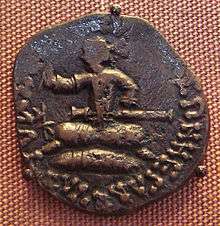
A section of the Central Asian Scythians (under Sai-Wang) is said to have taken southerly direction and after passing through the Pamirs it entered the Chipin or Kipin after crossing the Hasuna-tu (Hanging Pass) located above the valley of Kanda in Swat country.[59] Chipin has been identified by Pelliot, Bagchi, Raychaudhury and some others with Kashmir[60] while other scholars identify it with Kapisha (Kafirstan).[61][62] The Sai-Wang had established his kingdom in Kipin. S. Konow interprets the Sai-Wang as Śaka Murunda of Indian literature, Murunda being equal to Wang i.e. king, master or lord,[63] but Bagchi who takes the word Wang in the sense of the king of the Scythians but he distinguishes the Sai Sakas from the Murunda Sakas.[64] There are reasons to believe that Sai Scythians were Kamboja Scythians and therefore Sai-Wang belonged to the Scythianised Kambojas (i.e. Parama-Kambojas) of the Transoxiana region and came back to settle among his own stock after being evicted from his ancestral land located in Scythia or Shakadvipa. King Moga or Maues could have belonged to this group of Scythians who had migrated from the Sai country (Central Asia) to Chipin.[65]
Establishment of Mlechcha Kingdoms in Northern India
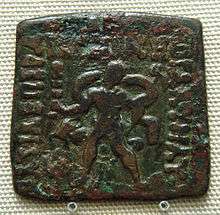
The mixed Scythian hordes that migrated to Drangiana and surrounding regions later spread further into north and south-west India via the lower Indus valley. Their migration spread into Sovira, Gujarat, Rajasthan and northern India, including kingdoms in the Indian mainland.
There are important references to the warring Mleccha hordes of the Sakas, Yavanas, Kambojas and Pahlavas in the Bala Kanda of the Valmiki Ramayana. H. C. Raychadhury glimpses in these verses the struggles between the Hindus and the invading hordes of Mlechcha barbarians from the northwest. The time frame for these struggles is the 2nd century BC onwards. Raychadhury fixes the date of the present version of the Valmiki Ramayana around or after the 2nd century AD.[66]
Mahabharata too furnishes a veiled hint about the invasion of the mixed hordes from the northwest. Vanaparava by Mahabharata contains verses in the form of prophecy deploring that "......the Mlechha (barbaric) kings of the Shakas, Yavanas, Kambojas, Bahlikas, etc. shall rule the earth un-righteously in Kaliyuga..."[67]
According to H. C. Ray Chaudhury, this is too clear a statement to be ignored or explained away.
Evidence about joint invasions
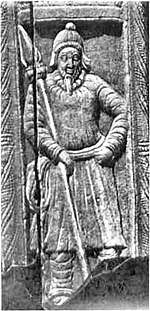
The Scythian groups that invaded India and set up various kingdoms included, besides the Sakas, other allied tribes, such as the Medii, Xanthii, and Massagetae. These peoples were all absorbed into the community of Kshatriyas of mainstream Indian society.[70]
The Shakas were formerly a people of the trans-Hemodos region—the Shakadvipa of the Puranas or the Scythia of the classical writings. Isidor of Charax (beginning of 1st century AD) attests them in Sakastana (modern Seistan). The Periplus of the Erythraean Sea (c. AD 70–80) also attests a Scythian district in lower Indus with Minnagra as its capital. Ptolemy (c. AD 140) also attests to an Indo-Scythia in south-western India which comprised the Patalene and Surastrene (Saurashtra) territories.
The 2nd century BC Scythian invasion of India, was in all probability carried out jointly by the Sakas, Pahlavas, Kambojas, Paradas, Rishikas and other allied tribes from the northwest.[71]
Main Indo-Scythian rulers
Khyber-Pakhtunkhwa and Eastern Pakistan
- Maues, c. 85–60 BC
- Vonones, c. 75–65 BC
- Spalahores, c. 75–65 BC, satrap and brother of King Vonones, and probably the later King Spalirises.
- Spalirises, c. 60–57 BC, king and brother of King Vonones.
- Spalagadames c. 50 BC, satrap, and son of Spalahores.
- Azilises, before 60 BC
- Azes I, c. 60–20 BC
- Zeionises, c. 10 BC – AD 10
- Kharahostes, c. 10 BC – AD 10
- Hajatria
Kshaharatas (Punjab, Pakistan and beyond)
- Liaka Kusuluka, satrap of Chuksa
- Kusulaka Patika, satrap of Chuksa and son of Liaka Kusulaka
- Bhumaka
- Nahapana (founder of the Western Satraps)
Aprācas (Bajaur, Khyber-Pakhtunkhwa, Pakistan)
- Vijayamitra (12 BC - AD 15), wife Rukhana
- Indravasu (c. AD 20), wife Vasumitra
- Vispavarman, wife Śiśirena
- Indravarman, wife Uttara
- Aspa (AD 15–45) [72] or Aspavarma (AD 15 - 45)
- Sasan [73]
Pāratas[74] (Balochistan, Pakistan)

Obv: Robed bust of Bhimarjuna left, wearing tiara-shaped diadem.
Rev: Swastika with legend surrounding.
1.70g. Senior (Indo-Scythian) 286.1 (Bhimajhuna)
- Yolamira, son of Bagareva (c. 125–150)
- Bagamira, son of Yolamira (c. 150)
- Arjuna, a second son of Yolamira (c. 150–160)
- Hvaramira, a third son of Yolamira (c. 160–175)
- Mirahvara, son of Hvaramira (c. 175–185)
- Miratakhma, another son of Hvaramira (c. 185–200)
- Kozana, son of Bagavharna (and perhaps grandson of Bagamira?) (c. 200–220)
- Bhimarjuna, son of Yolatakhma (and perhaps grandson of Arjuna?) (c. 220–235)
- Koziya, son of Kozana (c. 235–265)
- Datarvharna, son of Datayola I (possible grandson of Bhimarjuna) (c. 265–280)
- Datayola II, son of Datarvharna (c. 280–300)
"Northern Satraps" (Mathura area)
Western Satraps
- Nahapana (119–124)
- Chastana (c. 120), son of Ghsamotika
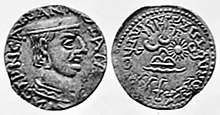
- Jayadaman, son of Chastana
- Rudradaman I (c. 130–150), son of Jayadaman
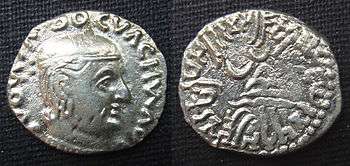
- Damajadasri I (170–175)
- Jivadaman (175 died 199)
- Rudrasimha I (175–188 died 197)
- Isvaradatta (188–191)
- Rudrasimha I (restored) (191–197)
- Jivadaman (restored) (197–199)
- Rudrasena I (200–222)
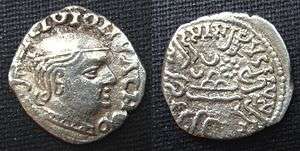
- Samghadaman (222–223)
- Damasena (223–232)
- Damajadasri II (232–239) with
- Viradaman (234–238)
- Yasodaman I (239)
- Vijayasena (239–250)
- Damajadasri III (251–255)
- Rudrasena II (255–277)
- Visvasimha (277–282)
- Bhratadarman (282–295)

- Visvasena (293–304)
- Rudrasimha II, son of Lord (Svami) Jivadaman (304–348) with
- Yasodaman II (317–332)
- Rudradaman II (332–348)
- Rudrasena III (348–380)
- Simhasena (380– ?)
- Rudrasena IV (382–388)
- Rudrasimha III (388–395)

Military actions
Descendants of the Indo-Scythians
Tadeusz Sulimirski notes that the Sacae also invaded parts of Northern India.[75] Weer Rajendra Rishi, an Indian linguist[76] has identified linguistic affinities between Indian and Central Asian languages, which further lends credence to the possibility of historical Sacae influence in Northern India.[75][77]
See also
- Ancient India and Central Asia
- Tillya Tepe
Notes
- The Decline and Fall of the Hindus: The Book on India's Regeneration
- Taagepera, Rein (1979). "Size and Duration of Empires: Growth-Decline Curves, 600 B.C. to 600 A.D". Social Science History. 3 (3/4): 115–138. doi:10.2307/1170959. JSTOR 1170959.
- Kharapallana and Vanaspara are known from an inscription discovered in Sarnath, and dated to the 3rd year of Kanishka, in which they were paying allegiance to the Kushanas. Source: "A Catalogue of the Indian Coins in the British Museum. Andhras etc." Rapson, p ciii
- "The titles "Kshatrap" and "Mahakshatrapa" certainly show that the Western Kshatrapas were originally feudatories" in Rapson, "Coins of the British Museum", p.cv
- World history from early times to A D 2000 by B .V. Rao: p.97
- A Brief History of India, by Alain Daniélou p.136
- India in a Globalised World, by Sagarika Dutt p.24
- Ancient India, by Ramesh Chandra Majumdar p. 234
- "Arrian: Anabasis Alexandri: Book VIII (Indica); Section V". Ancient History Sourcebooks. Fordham University. Retrieved 21 January 2019.
- Ptolemy vi, xiii (1932), p. 143.
- Ronca (1971), pp. 39, 102, 108.
- Abdullaev, Kazim (2007). "Nomad Migration in Central Asia (in After Alexander: Central Asia before Islam)". Proceedings of the British Academy. 133: 87–98.
- Greek Art in Central Asia, Afghan – Encyclopaedia Iranica.
- Also a Saka according to this source:
- Millward (2007), p. 13.
- Beckwith, Christopher I. (2015). Greek Buddha: Pyrrho's Encounter with Early Buddhism in Central Asia. Princeton University Press. p. 5. ISBN 9781400866328.
- Herodotus VII 65
- Attwood, Jayarava. Possible Iranian Origins for the Śākyas and Aspects of Buddhism. pp. 47–69.
- Beckwith, Christopher I. (2015). Greek Buddha: Pyrrho's Encounter with Early Buddhism in Central Asia. Princeton University Press. pp. 1–21. ISBN 9781400866328.
- Mookerji, Radhakumud (1966). Chandragupta Maurya and His Times. Motilal Banarsidass. p. 27. ISBN 9788120804050.; Mookerji, Radha Kumud (1957). "The Foundation of the Mauryan Empire". In K. A. Nilakanta Sastri (ed.). A Comprehensive History of India, Volume 2: Mauryas and Satavahanas. Orient Longmans. p. 4.: "The Mudrarakshasa further informs us that his Himalayan alliance gave Chandragupta a composite army ... Among these are mentioned the following : Sakas, Yavanas (probably Greeks), Kiratas, Kambojas, Parasikas and Bahlikas."
- Shashi, Shyam Singh (1999). Encyclopaedia Indica: Mauryas. Anmol Publications. p. 134. ISBN 9788170418597.: "Among those who helped Chandragupta in his struggle against the Nandas, were the Sakas (Scythians), Yavanas (Greeks), and Parasikas (Persians)"
- D. B. Spooner (1915). "The Zoroastrian Period of Indian History" (PDF). Journal of the Royal Asiatic Society of Great Britain and Ireland. 47 (3): 416–417. doi:10.1017/S0035869X00048437. JSTOR 25189338.: "After Alexander's death, when Chandragupta marched on Magada, it was with largely the Persian army that he won the throne of India. The testimony of the Mudrarakshasa is explicit on this point, and we have no reason to doubt its accuracy in matter[s] of this kind."
- Mookerji, Radhakumud (1966). Chandragupta Maurya and His Times. Motilal Banarsidass. p. 210. ISBN 9788120804050.
- Grousset, Rene (1970). The Empire of the Steppes. Rutgers University Press. pp. 32. ISBN 978-0-8135-1304-1.
- Shiji, chap. 123 translated in: Burton Watson (1993), p. 234.
- Han Shu 61 4B Original tex: 西擊塞王。塞王南走遠徙,月氏居其地。
- Craig Benjamin (October 2003). "The Yuezhi Migration and Sogdia". Transoxiana Webfestschrift Series I: Eran Ud Aneran.
- Lena Jonson (3 October 2006). Tajikistan in the New Central Asia: Geopolitics, Great Power Rivalry and Radical Islam. I.B.Tauris. p. 25. ISBN 978-1-84511-293-6.
- Bailey, H.W. (1996) [14 April 1983]. "Chapter 34: Khotanese Saka Literature". In Ehsan Yarshater (ed.). The Cambridge History of Iran, Vol III: The Seleucid, Parthian, and Sasanian Periods, Part 2 (reprint ed.). Cambridge University Press. pp. 1230–1231. ISBN 978-0521246934.
- Justin XL.II.2
- Isodor of Charax, Sathmoi Parthikoi, 18.
- Political History of Ancient India, 1996, p 693.
- "Parthian stations". Parthia.com. Retrieved 14 March 2012.
- Ahmad Hasan Dani. History of Civilizations of Central Asia, Volume 2. Motilal Banarsidass Publ. p. 191-207.
- "Periplus of the Erythraean Sea, 38". Fordham.edu. Retrieved 14 March 2012.
- The dynastic art of the Kushans, John Rosenfield, p 130
- Kshatrapasa pra Kharaostasa Artasa putrasa. See: Political History of Ancient India, 1996, p 398, H. C. Raychaudhury, B. N. Mukerjee; Ancient India, 1956, pp 220–221, R. K. Mukerjee
- Ancient India, pp 220–221, R. k. Mukerjee; Corpus Inscriptionum Indicarum, Vol II, Part 1, p 36, D S Konow
- Source: "A Catalogue of the Indian Coins in the British Museum. Andhras etc..." Rapson, p ciii
- "A gap in Puranic history". Boloji.com. 14 March 2004. Archived from the original on 14 January 2010. Retrieved 14 March 2012.
- Francine Tissot "Gandhara", p74
- Wilcox and McBride (1986), p. 12.
- Photographic reference here Archived 10 March 2007 at the Wayback Machine.
- "Let us remind that in Sirkap, stone palettes were found at all excavated levels. On the contrary, neither Bhir-Mound, the Maurya city preceding Sirkap on the Taxila site, nor Sirsukh, the Kushan city succeeding her, did deliver any stone palettes during their excavations", in "Les palettes du Gandhara", p89. "The terminal point after which such palettes are not manufactured anymore is probably located during the Kushan period. In effect, neither Mathura nor Taxila (although the Sirsukh had only been little excavated), nor Begram, nor Surkh Kotal, neither the great Kushan archaeological sites of Soviet Central Asia or Afghanistan have yielded such objects. Only four palettes have been found in Kushan-period archaeological sites. They come from secondary sites, such as Garav Kala and Ajvadz in Soviet Tajikistan and Jhukar, in the Indus Valley, and Dalverzin Tepe. They are rather roughly made." In "Les Palettes du Gandhara", Henri-Paul Francfort, p 91. (in French in the original)
- Metropolitan Museum of Art notice
- Ahmad Hasan Dani et al., History of Civilizations of Central Asia, 1999, p 201, Unesco
- Richard Salomon, "An Inscribed Silver Buddhist Reliquary of the Time of King Kharaosta and Prince Indravarman", Journal of the American Oriental Society, Vol. 116, No. 3 (July - September 1996), pp. 418-452
- "Afghanistan, carrefour en l'Est et l'Ouest" p.373. Also Senior 2003
- Des Indo-Grecs aux Sassanides, Rika Gyselen, Peeters Publishers, 2007, p.103
- Source:"Butkara I", Faccena
- "Gandhara" Francine Tissot
- The Turin City Museum of Ancient Art Text and photographic reference: Terre Lontane O2 Archived 12 December 2006 at the Wayback Machine
- For the pilaster showing a man in Greek dress File:ButkaraPilaster.jpg.
- Facenna, "Sculptures from the sacred area of Butkara I", plate CCCLXXI. The relief is this one, showing Indo-Scythians dancing and reveling, with on the back side a relief of a standing Buddha (not shown).
- Faccenna, "Sculptures from the sacred area of Butkara I", plate CCCLXXII
- Problems of Chronology in Gandharan Art pp.35-51, 2017
- Greco-Buddhist Art of Gandhara p.491
- "Book Excerptise: Indian Mathematics and Astronomy: Some Landmarks by S. Balachandra Rao".
- Serindia, Vol I, 1980 Edition, p 8, M. A. Stein
- H. C. Raychaudhury, B. N. Mukerjee; Early History of North India, p 3, S. Chattopadhyava; India and Central Asia, p 126, P. C. Bagchi
- Epigraphia Indiaca XIV, p 291 S Konow; Greeks in Bactria and India, p 473, fn, W. W. Tarn; Yuan Chwang I, pp 259–60, Watters; Comprehensive History of India, Vol I, p 189, N. K. Sastri; History and Culture of Indian People, The Age of Imperial Unity, 122; History and Culture of Indian People, Classical Age, p 617, R. C. Majumdar, A. D. Pusalkar.
- Scholars like E. J. Rapson, L. Petech etc. also connect Kipin with Kapisha. Levi holds that prior to AD 600, Kipin denoted Kashmir, but after this it implied Kapisha See Discussion in The Classical Age, p 671.
- Corpus Inscriptionum Indicarum, II. 1. XX f; cf: Early History of North India, pp 54, S Chattopadhyaya.
- India and Central Asia, 1955, p 124, P. C. Bagchi; Geographical Data in Early Puranas, 1972, p 47, M. R. Singh.
- See: Political History of Ancient India, 1996, p fn 13, B. N. Mukerjee; Chilas, Islamabad, 1983, no 72, 78, 85, pp 98, 102, A. H. Dani
- Political History of Ancient India, 1996, pp 3–4.
-
- viparite tada loke purvarupa.n kshayasya tat || 34 ||
- bahavo mechchha rajanah prithivyam manujadhipa |
- mithyanushasinah papa mrishavadaparayanah || 35 ||
- Andhrah Shakah Pulindashcha Yavanashcha naradhipah |
- Kamboja Bahlikah Shudrastath abhira narottama || 36 ||
- — (MBH 3.188.34–36).
- "In Nagarjunakonda Scythian influence is noticed and the cap and coat of a soldier on a pillar may be cited as an example.", in Sivaramamurti, C. (1961). Indian Sculpture. Allied Publishers. p. 51.
- "A Scythian dvarapala standing wearing his typical draperies, boots and head dress. Distinct ethnic and sartorial characteristics are noreworthy.", in Ray, Amita (1982). Life and Art of Early Andhradesa. Agam. p. 249.
- History and Culture of Indian People, The Vedic Age, pp 286–87, 313–14.
- Intercourse Between India and the Western World, pp 75–93, H. G. Rawlinson
- e.g.: Aspa.bhrata.putrasa. See: An Inscribed Silver Buddhist Reliquary of the Time of King Kharaosta and Prince Indravarman, Jounranal of the American Oriental Society, Vol 116, No 3, 1996, p 448, Richard Saloman.
- An Inscribed Silver Buddhist Reliquary of the Time of King Kharaosta and Prince Indravarman, Jounranal of the American Oriental Society, Vol 116, No 3, 1996, p 448, Richard Saloman.
- Further Light on the Paratarajas
- Sulimirski, Tadeusz (1970). The Sarmatians. Volume 73 of Ancient peoples and places. New York: Praeger. pp. 113–114.
The evidence of both the ancient authors and the archaeological remains point to a massive migration of Sacian (Sakas)/Massagetan tribes from the Syr Daria Delta (Central Asia) by the middle of the second century B.C. Some of the Syr Darian tribes; they also invaded North India.
- Indian Institute of Romani Studies Archived 8 January 2013 at Archive.today
- Rishi, Weer Rajendra (1982). India & Russia: linguistic & cultural affinity. Roma. p. 95.
References
- Bailey, H. W. 1958. "Languages of the Saka." Handbuch der Orientalistik, I. Abt., 4. Bd., I. Absch., Leiden-Köln. 1958.
- Faccenna D., "Sculptures from the sacred area of Butkara I", Istituto Poligrafico Dello Stato, Libreria Dello Stato, Rome, 1964.
- Harmatta, János, ed., 1994. History of civilizations of Central Asia, Volume II. The development of sedentary and nomadic civilizations: 700 B.C. to A.D. 250. Paris, UNESCO Publishing.
- Hill, John E. 2004. The Peoples of the West from the Weilue 魏略 by Yu Huan 魚豢: A Third Century Chinese Account Composed between AD 239 and 265. Draft annotated English translation.
- Hill, John E. (2009) Through the Jade Gate to Rome: A Study of the Silk Routes during the Later Han Dynasty, 1st to 2nd Centuries AD. BookSurge, Charleston, South Carolina. ISBN 978-1-4392-2134-1.
- Hulsewé, A. F. P. and Loewe, M. A. N. 1979. China in Central Asia: The Early Stage 125 BC – AD 23: an annotated translation of chapters 61 and 96 of the History of the Former Han Dynasty. E. J. Brill, Leiden.
- Huet, Gerard (2010) "Heritage du Sanskrit Dictionnaire, Sanskrit-Francais," p. 128.
- Litvinsky, B. A., ed., 1996. History of civilizations of Central Asia, Volume III. The crossroads of civilizations: A.D. 250 to 750. Paris, UNESCO Publishing.
- Liu, Xinru 2001 "Migration and Settlement of the Yuezhi-Kushan: Interaction and Interdependence of Nomadic and Sedentary Societies." Journal of World History, Volume 12, No. 2, Fall 2001. University of Hawaii Press, pp 261–292. .
- Bulletin of the Asia Institute: The Archaeology and Art of Central Asia. Studies From the Former Soviet Union. New Series. Edited by B. A. Litvinskii and Carol Altman Bromberg. Translation directed by Mary Fleming Zirin. Vol. 8, (1994), pp 37–46.
- Millward, James A. (2007). Eurasian Crossroads: A History of Xinjiang. Columbia University Press, New York. ISBN 978-0-231-13924-3.
- Pulleyblank, Edwin G. 1970. "The Wu-sun and Sakas and the Yüeh-chih Migration." Bulletin of the School of Oriental and African Studies 33 (1970), pp 154–160.
- Ptolemy (1932). The Geography. Translated and edited by Edward Luther Stevenson. 1991 unabridged reproduction. Dover Publications, Mineola, N. Y. ISBN 0-486-26896-9 (pbk)
- Puri, B. N. 1994. "The Sakas and Indo-Parthians." In: History of civilizations of Central Asia, Volume II. The development of sedentary and nomadic civilizations: 700 B.C. to A.D. 250. Harmatta, János, ed., 1994. Paris: UNESCO Publishing, pp 191–207.
- Ronca, Italo (1971). Ptolemaios Geographie 6,9–21. Ostrian und Zentralasien, Teil I. IsMEO — ROM.
- Watson, Burton. Trans. 1993. Records of the Grand Historian of China: Han Dynasty II (Revised Edition). Translated from the Shih chi of Ssu-ma Ch'ien. Chapter 123: The Account of Ta-yüan. Columbia University Press. ISBN 0-231-08167-7
- Wilcox, Peter and Angus McBride (1986). Rome's Enemies (3): Parthians and Sassanid Persians (Men-at-Arms). Osprey Publishing; illustrated edition. ISBN 978-0-85045-688-2.
- Yu, Taishan. 1998. A Study of Saka History. Sino-Platonic Papers No. 80. July 1998. Dept. of Asian and Middle Eastern Studies, University of Pennsylvania.
- Yu, Taishan. 2000. A Hypothesis about the Source of the Sai Tribes. Sino-Platonic Papers No. 106. September 2000. Dept. of Asian and Middle Eastern Studies, University of Pennsylvania.
- Political History of Ancient India, 1996, H. C. Raychaudhury
- Hindu Polity, A Constitutional history of India in Hindu Times, 1978, K. P. Jayswal
- Geographical Data in Early Puranas, 1972, M. R. Singh
- India and Central Asia, 1955, P. C. Bagchi.
- Geography of Puranas, 1973, S. M. Ali
- Greeks in Bactria and India, W. W. Tarn
- Early History of North India, S. Chattopadhyava
- Sakas in Ancient India, S. Chattopadhyava
- Development of Kharoshthi script, C. C. Dasgupta
- Ancient India, 1956, R. K. Mukerjee
- Ancient India, Vol III, T. L. Shah
- Hellenism in Ancient India, G. N. Banerjee
- Manu and Yajnavalkya, K. P. Jayswal
- Anabaseeos Alexanddrou, Arrian
- Mathura lion capital inscriptions
- Corpus Inscriptionium Indicarum, Vol II, Part I, S. Konow
External links
| Wikimedia Commons has media related to Indo-Scythians. |
| Timeline and cultural period |
Northwestern India (Punjab-Sapta Sindhu) |
Indo-Gangetic Plain | Central India | Southern India | ||
| Upper Gangetic Plain (Ganga-Yamuna doab) |
Middle Gangetic Plain | Lower Gangetic Plain | ||||
| IRON AGE | ||||||
| Culture | Late Vedic Period | Late Vedic Period (Srauta culture)[lower-alpha 1] Painted Grey Ware culture |
Late Vedic Period (Shramanic culture)[lower-alpha 2] Northern Black Polished Ware |
Pre-history | ||
| 6th century BC | Gandhara | Kuru-Panchala | Magadha | Adivasi (tribes) | ||
| Culture | Persian-Greek influences | "Second Urbanisation" Rise of Shramana movements Jainism - Buddhism - Ājīvika - Yoga |
Pre-history | |||
| 5th century BC | (Persian conquests) | Shaishunaga dynasty | Adivasi (tribes) | |||
| 4th century BC | (Greek conquests) | Nanda empire | ||||
| HISTORICAL AGE | ||||||
| Culture | Spread of Buddhism | Pre-history | Sangam period (300 BC – 200 AD) | |||
| 3rd century BC | Maurya Empire | Early Cholas Early Pandyan Kingdom Satavahana dynasty Cheras 46 other small kingdoms in Ancient Thamizhagam | ||||
| Culture | Preclassical Hinduism[lower-alpha 3] - "Hindu Synthesis"[lower-alpha 4] (ca. 200 BC - 300 AD)[lower-alpha 5][lower-alpha 6] Epics - Puranas - Ramayana - Mahabharata - Bhagavad Gita - Brahma Sutras - Smarta Tradition Mahayana Buddhism |
Sangam period (continued) (300 BC – 200 AD) | ||||
| 2nd century BC | Indo-Greek Kingdom | Shunga Empire Maha-Meghavahana Dynasty |
Early Cholas Early Pandyan Kingdom Satavahana dynasty Cheras 46 other small kingdoms in Ancient Thamizhagam | |||
| 1st century BC | ||||||
| 1st century AD | Kuninda Kingdom | |||||
| 2nd century | Kushan Empire | |||||
| 3rd century | Kushano-Sasanian Kingdom | Kushan Empire | Western Satraps | Kamarupa kingdom | Kalabhra dynasty Pandyan Kingdom (Under Kalabhras) | |
| Culture | "Golden Age of Hinduism"(ca. AD 320-650)[lower-alpha 7] Puranas Co-existence of Hinduism and Buddhism | |||||
| 4th century | Kidarites | Gupta Empire Varman dynasty |
Kalabhra dynasty Pandyan Kingdom (Under Kalabhras) Kadamba Dynasty Western Ganga Dynasty | |||
| 5th century | Hephthalite Empire | Alchon Huns | Kalabhra dynasty Pandyan Kingdom (Under Kalabhras) Vishnukundina | |||
| 6th century | Nezak Huns Kabul Shahi |
Maitraka | Adivasi (tribes) | Badami Chalukyas Kalabhra dynasty Pandyan Kingdom (Under Kalabhras) | ||
| Culture | Late-Classical Hinduism (ca. AD 650-1100)[lower-alpha 8] Advaita Vedanta - Tantra Decline of Buddhism in India | |||||
| 7th century | Indo-Sassanids | Vakataka dynasty Empire of Harsha |
Mlechchha dynasty | Adivasi (tribes) | Pandyan Kingdom (Under Kalabhras) Pandyan Kingdom(Revival) Pallava | |
| 8th century | Kabul Shahi | Pala Empire | Pandyan Kingdom Kalachuri | |||
| 9th century | Gurjara-Pratihara | Rashtrakuta dynasty Pandyan Kingdom Medieval Cholas Pandyan Kingdom (Under Cholas) Chera Perumals of Makkotai | ||||
| 10th century | Ghaznavids | Pala dynasty Kamboja-Pala dynasty |
Kalyani Chalukyas Medieval Cholas Pandyan Kingdom (Under Cholas) Chera Perumals of Makkotai Rashtrakuta | |||
References and sources for table References
Sources
| ||||||
